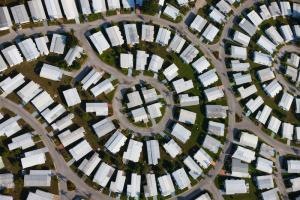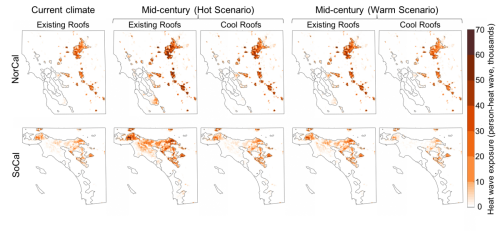Cool Roofs Can Help Shield California’s Cities Against Heat Waves
New Berkeley Lab study finds that in reducing air temperatures, cool roofs could protect urbanites from heat waves
This summer alone, intense heat waves have been to blame for at least 11 deaths in Japan, a record-breaking 45.9-degree Celsius temperature in France, and a heat advisory affecting 147 million people on the U.S. East Coast. Conjectured as the “new normal,” these extreme air temperatures can heat our bodies, causing sunstrokes or even organ damage.

Aerial view of white roofed homes and streets forming circular patterns; St. Petersburg, Florida, USA
A new study by researchers at the Department of Energy’s Lawrence Berkeley National Laboratory (Berkeley Lab) shows that if every building in California sported “cool” roofs by 2050, these roofs would help contribute to protecting urbanites from the consequences of these dangerous heatwaves. Their study, “Interacting implications of climate change, population dynamics, and urban heat mitigation for future exposure to heat extremes,” was recently published in the journal Environmental Research Letters.

In this study, a heat wave consists of at least three consecutive days with maximum air temperature of 35 C or higher. The simulation above illustrates the extent to which cool roofs could reduce annual population exposure to heat waves in Northern and Southern California in mid-century under hot and warm scenarios, driven by high greenhouse gas emissions and more modest emissions, respectively.
The researchers predict that heat waves are likely to become two to 10 times more frequent across the state by mid-century. But if cool roofs were adopted throughout California’s most populous areas – the San Francisco Bay Area, Los Angeles, San Diego, and Sacramento – by 2050 these reflective roofs could bring down heat wave exposures (defined as each time a person experiences a heat wave) by 35 million each year, compared to an estimated 80 million heat wave cases in 2050 with no increase in cool roof adoption. This is the latest example of Berkeley Lab’s research into the potential for reflective roofs, walls, and pavements to mitigate urban heat, reduce air conditioning usage, and save water.
“Urban spaces are a small fraction of the globe, but they are where most people live,” said Pouya Vahmani, a postdoctoral research fellow in Berkeley Lab’s Climate and Ecosystem Sciences Division and lead author of the study. “If we’re able to cool those areas even a little bit, it can have a huge impact on health and roll back significant impacts of climate change.”
Predicting future heat waves
City dwellers are more vulnerable than their rural counterparts to a heat wave’s negative effects. Due to the urban heat island effect, air temperatures spike several degrees higher in cities than in surrounding vegetated areas. Built surfaces readily absorb daytime heat and release it at night, keeping cities warmer overnight as well.
When nighttime temperatures remain elevated, human bodies struggle to cool down and recover from the day’s scorching heat. In summer, when urban heat island effects peak, human health can be severely compromised. Add a heat wave to this already heat-stressed environment, and impacts exacerbate.
In this new study, the Berkeley Lab researchers had two goals. First, they wanted to predict heat wave occurrences across California’s 29 major urban counties between now and 2050. They used regional climate conditions between 2001 and 2015 as a starting point to simulate mid-century climate under two global warming scenarios.
Combining these climate conditions with high-resolution satellite images allowed them to incorporate urban features like buildings, roads, and vegetation, which absorb and release heat, and for more accurate future climate predictions. Then, the researchers used county-level population estimates for 2050 to assess population exposure to future heat waves.
“We wanted to gain a better picture of future climate change risks for California’s urban environments and adaptation options,” said Andrew Jones, a scientist in Berkeley Lab’s Climate and Ecosystem Sciences Divisionand co-author of the study. “Making such refined and realistic predictions can help urban planners and citizens prepare for heat events in an increasingly warming future.”
Their study found that heat waves with air temperatures exceeding 35 degrees Celsius (95 degrees Fahrenheit) and lasting at least three consecutive days become two to 10 times more frequent under future global warming scenarios. With the added burden of urban centers getting more populous, the researchers expect that by 2050 there will be 80 million heat wave exposure cases in California each year, compared to an average of 37 million cases annually under current climate conditions.
“That’s more than double the cases we’ve seen under current climatic conditions,” Vahmani said.
Also, regions like downtown Los Angeles and Santa Clara, Alameda, and Orange Counties that historically benefited from cool sea breezes will experience more frequent, more intense heat waves by mid-century. “That’s significant,” Vahmani said, “because many of these regions aren’t prepared to deal with the extreme heat.”
Cool roofs to the rescue
Coating roofs white or installing sunlight-reflecting tiles in urban clusters could be one solution, according to the researchers.
“It’s not necessarily a complicated or costly technology,” Vahmani said. “But cool roofs, in general, are more effective if everyone adopts them.”
The second goal of their study was to analyze the effectiveness of cool roofs in mitigating heat wave impacts. To do that, the research team repeated the same high-resolution regional climate simulations, only this time replacing all existing building roofs with cool roofs. Specifically, they wanted to know if the increased solar reflectance might shield urban populations against heat waves.
They found that if every building in California sported cool roofs by 2050, it could bring down the annual number of heat wave exposures in California to 45 million from 80 million .
This mitigation potential surprised the team. “Although a small percentage of California’s land is urban, I was surprised at how effective cool roofs could be in pushing back risks of heat extremes,” Jones said.
Alongside reduced exposure to heat waves and associated health risks, this study predicts that widespread adoption of cool roofs could drastically cut energy demands by reducing air conditioning use.
Jones acknowledges that 100% conversion to cool roofs by 2050 may be challenging. While cities like Los Angeles mandate cool roofs for new constructions, retrofitting existing buildings can be expensive.
The team now wants to find the minimum cool roof coverage needed to accrue benefits similar to those reported in the study.
But the positive effect of cool roofs will be limited to reducing day time temperatures when the roofs reflect sunlight. At night, when roads and packed buildings slowly release heat, these roofs aren’t capable of directly providing cooling benefits.
“What they can do is reduce the amount of heat cities absorb during the day,” Jones said, “which can indirectly lower the heat available for release in the night.”
Source: Berkeley Lab
- 216 reads
Human Rights
Ringing FOWPAL’s Peace Bell for the World:Nobel Peace Prize Laureates’ Visions and Actions

Protecting the World’s Cultural Diversity for a Sustainable Future

The Peace Bell Resonates at the 27th Eurasian Economic Summit

Declaration of World Day of the Power of Hope Endorsed by People in 158 Nations

Puppet Show I International Friendship Day 2020

